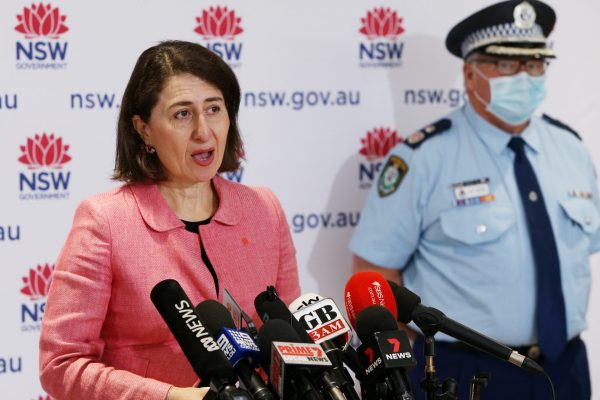Things feel like they’ve taken a turn for the apocalyptic lately. Between the fall of Afghanistan, the IPCC report and the exponential growth of Covid cases in NSW, every time you turn on the news things are spinning out of control. Not because there’s no hope, but because of the hubris of some of our leaders.

Afghanistan is Australia’s longest war. It was a failure. It was devastating to watch those desperate scenes at Kabul’s airport knowing Australia played a direct part in creating them. Our troops were in Afghanistan for 20 years, during which time tens of thousands of Afghans died, 41 Australian soldiers sacrificed their lives, and 39 Afghans were allegedly murdered by Australian soldiers committing war crimes. Twenty years of engagement with virtually nothing to show for it.
When then-prime minister John Howard explained his decision to take Australia to war, he said the immediate goal was to ensure that Afghanistan could “never again serve as a base from which terrorists can operate”. Now the Taliban is back charge like it’s 2001. Yet Howard, in an interview with The Canberra Times, could not bring himself to acknowledge any failure. He even told The Australian the war had served the purpose of fostering deeper ties with the United States. Even if that were true, it is a pathetic justification for so much misery.
Speaking of misery, Prime Minister Scott Morrison extinguished any hope of permanent protection for the 4000 or so Afghan refugees here on temporary protection visas. They are safe, but only for now. In contrast to the offer of 20,000 humanitarian places from Canada and UK, Australia offered a paltry few thousand within the limits of our existing program. The miserly response stands in contrast to Australia’s past responses to humanitarian crises, including Tony Abbott offering 12,000 Syrian refugees resettlement in 2015. As always with Australian refugee policy, the cruelty is the point.
As Allan Behm, head of the Australia Institute’s International & Security Affairs program, and other experts have observed, the war in Afghanistan was doomed from the start because it rested on the assumption that terrorism could be defeated by military force. It cannot be, because terrorism is a political movement, not a military one.
Despite our failure, Australia’s choice to join the war in Afghanistan 20 years ago leaves us with a clear responsibility to the people of Afghanistan now. For months the federal government was warned that thousands of interpreters and other Afghans who supported our troops or our aid projects were at risk and required urgent evacuation. Yet the news that just 26 people were rescued on the first evacuation flight (with space for 128) is simply macabre. To be rescued, those who helped Australia will now have to put a target on their back by travelling to Kabul’s airport through Taliban-controlled checkpoints, while Peter Dutton smears their character on Australian TV. If this is the best we can do, it is an indictment of us all.
Domestically, the exponential growth in Covid cases in NSW grows more depressing each day. It was surreal to watch the NSW Premier speak on Thursday of “light at the end of the tunnel” while announcing record case numbers. No practical changes to the NSW settings were offered, because they were “just right”. Instead, blame was allocated to the victims.
In the same press conference, her own health advisers admitted transmissions were not occurring because people were doing the wrong thing, but because there are many young unvaccinated people in essential jobs. By Friday, Berejiklian’s “just right” settings were tightened, including a curfew and an outdoor mask mandate – neither of which will address the workplace transmission that seems to be the source of the problem.
In any case, it’s too little, too late. Berejiklian made the fatal mistake of believing her own press about NSW avoiding lockdowns, locked down way too late, and now she and the rest of Australia are victims of her hubris.
The NSW wave has exposed massive Covid response failures at both a state and federal level. Aboriginal and Torres Strait Islanders are amongst the most vulnerable populations, which is why they were supposed to be prioritised in phase 1b of the vaccine rollout. But vaccination rates in some Aboriginal communities are half that of the general population. Equally, people with disabilities, aged care workers and others appear to be having great difficulty accessing the vaccine, despite being priority populations within the rollout.
As a 39-year-old living in the ACT, I booked my first Pfizer jab (couldn’t find an AZ one) for early September. There is every chance I will get my first jab before thousands of Aboriginal communities get theirs, and there are now cases within Aboriginal communities in western NSW. Aboriginal community-controlled health organisations led the world in protecting First Nations communities from the pandemic while a vaccine was just a hope. To see the virus enter these communities unprotected, when vaccines are now available, is an egregious failure of government. We just have to hope it does not prove a fatal one for Aboriginal communities.
Canberrans are lucky. There has been little complacency from the ACT government. Learning from the mistakes and experiences of other jurisdictions, we entered lockdown with just one active case. Some laughed at this as an overreaction, but within a week one case turned into 83, half of them under 19.5 years of age.
“I just see young people being horribly exposed by the decision of another government and I don’t know what I can do to protect my community against that,” said Chief Minister Andrew Barr this week.
Barr started an important national discussion when he said the NSW Premier was making decisions not just for her own jurisdiction, but for the entire east coast of Australia.
Of course, we must have a national discussion about what it means to open up and “live with the virus” – but all that is predicated on achieving vaccination rates that protect the whole community. And that still seems a long way off.
Between the Lines Newsletter
The biggest stories and the best analysis from the team at the Australia Institute, delivered to your inbox every fortnight.
You might also like
Two new housing policies, both doomed to fail
The government’s latest housing affordability policies, “help to buy” and “build to rent” are the latest in a long line of policies from both major parties that will do nothing to ease the housing crisis.
Private health insurance is a dud. That’s why a majority of Australians don’t have it
Right now, final submissions are being made by private health insurers to the government for an increase in insurance premiums next year.
Pay a fortune in premiums or risk losing everything – the brutal reality of Australia’s insurance crisis
Struggling families who ditch their home and contents insurance would lose three-quarters of their wealth if their home was destroyed, according to new research by The Australia Institute.


